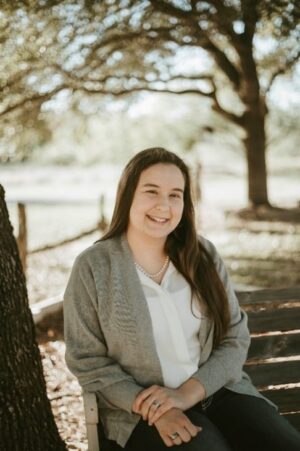To celebrate some of the brightest young minds in our country collaborating with the National Laboratories Office of the Texas A&M University System (NLO) we would like to introduce you to Kara Wilke. Miss Wilke will receive her Bachelor of Science from the Texas A&M University College of Engineering in Nuclear Engineering in the Spring of 2024. Wilke, an accomplished young woman that has already contributed her time to projects at the Center of Small Modular Reactors (CASMER) and as an employed researcher at the Thermal Hydraulic Research Lab (THRL).

Kara grew up on a small farm outside the Bryan – College Station Area. Her neighbors were professors that encouraged and motivated her to take on an educational path that would add to the skill sets that she developed growing up on a farm. In her own words, “My dad would often ask me to hold a wrench or entrust me with caring for our livestock; I learned how to service instruments for oil field drilling rigs and hydraulic systems before high school.” It was a visit during high school to the Thermal-Hydraulic Research Laboratory at Texas A&M University where Dr. Rodolfo Vaghetto met with her and turned her interest to nuclear engineering.
Both an academic, and a practitioner of nuclear engineering, Miss Wilke has played an integral role as a member of the National Science and Security Consortium (NSSC) throughout her tenure as a student at Texas A&M University. Realized by completing ambitious projects like identifying laser-induced dyes suitable for two distinct working fluids. With those under her belt she quickly moved into developing protocol for precision in data analysis. From theory development to writing code and mastering the nuances of laser technology and high-speed cameras, Kara has done it all.
In 2021, after a winter storm terrorized modern Texas, Miss Wilke found herself presenting her own research in front of U.S. Congressman Michael McCaul, and Former Secretary of Energy, Rick Perry, on the topic of how molten salt reactors (MSRs), small modular ones, can contribute to the stabilization of power grids during winter storms. MSRs, especially those with fuel in the molten salt, offer lower operating pressures, and higher temperatures. They can withstand heat and ice.
Currently, a remote collaborator with Sandia National Laboratories in Albuquerque, New Mexico, Ms. Wilke studies and assesses the dynamic response of operating and next generation nuclear power plants under accident conditions. Kara has studied the behavior of passive safety systems and considered a broad range of ways in which their degraded performance could lead to events that might result in damage to nuclear fuel and a potential release of fission products to the environment. She has more recently been studying models associated with transport of tritium in reactor systems due to its relevance to the assessment of potential impacts on human health if inadvertently released from advanced reactor concepts.
Dr. David L. Luxat, Manager, Severe Accident Modeling & Analysis, and Resident Fellow, Nuclear Technology, CMC, at Sandia National Laboratories had this to share about Ms. Wilke, “Kara places a significant emphasis on the quality of her work. She spends significant amounts of her own personal time learning new methods to enable her to make contributions of increasing impact. Kara has expanded well beyond her focus in experimental work to also develop her expertise in computational modeling and simulation.”
“I am deeply grateful to the professors and colleagues at Sandia National Laboratory for all the lessons learned. They have played an instrumental role paramount in shaping me into the student and researcher that I am today. Their guidance and mentorship have instilled in me a great confidence and the courage to embark on my next adventure with excitement and enthusiasm.” Said Kara Wilke.

Looking ahead past graduation ceremonies this coming Spring, Miss Wilke is considering graduate studies within the field of nuclear engineering.
The National Laboratories Office Director of Workforce Development, Janelle Salinas said, “The National Laboratories Office wishes Kara the absolute best as she continues to pursue her studies in Nuclear Engineering. From one Aggie to another; thanks, and Gig’em! We are enormously proud to support you and the work that you have accomplished in partnership with our national laboratories. We can’t wait to see what you do next.”
Photography by Eddy Constancio Photography
___
The Texas A&M University System is one of the largest systems of higher education in the nation, with a budget of $7.2 billion. Through a statewide network of 11 universities, a comprehensive health science center, eight state agencies, and the RELLIS Campus, the Texas A&M System educates more than 152,000 students and makes more than 24 million additional educational contacts through service and outreach programs each year. System-wide, research and development expenditures exceed $1 billion and help drive the state’s economy.
The Texas A&M University System’s National Laboratories Office Supports the Department of Energy’s National Laboratories in execution of their missions as they relate to national security and service.
